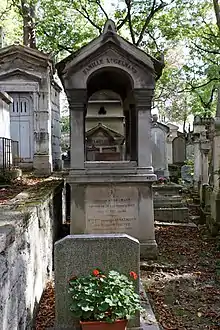Georges Kugelmann
Georges Kugelmann (1809–1882) was born in Kassel, where he served his apprenticeship as a compositor. Soon after, he went to Paris, where he was employed in the office of Ambroise Firmin-Didot. After trying publishing, he entered into a partnership with Mr. d'Aubusson and established a small print shop in the Passage des Panoramas and later at rue Feydeau in the 2nd arrondissement in Paris.[1]

In the course of a few years, his partner died. After being naturalized as a French citizen, Kugelmann started printing business on his own account. He finally established his Imprimerie Kugelmann at 13, Rue de la Grange-Batelière (9th arrondissement). He was the printer of the French principal newspapers Le Gaulois and Le Figaro,[2] as well as the other important weekly and daily publications.[3] His wife Helena Kugelmann (née Pfeiffer, 1821–1900) survived him. His son Josef Kugelmann (1844–1902) succeeded him after his death. Georges Kugelmann-Benda (1883–1954) a distinguished artist and scene decorator, was Georges Kugelmann's grandson. They are all buried at Père Lachaise Cemetery in Paris.
References
- "Obituary". Printing Times and Lithographer, an Illustrated Monthly Technical and Fine Art Journal of Typography, Lithography, Engraving, Paper-making, and the Auxiliary Trades. London: Wyman and Sons. 8: 260. October 15, 1882.
- "L'incident Villemessant – de Noé". Revue des grands procès contemporains (in French). Paris: Chevalier–Marescq et Cie. Tome IV: 435-510. 1886.
- "Nécrologie". Chronique / 2me Partie: Journal Général de l'imprimerie et de la librairie. 2me série (in French). Paris: Cercle de la librairie, de l'imprimerie. Tome XXVI (39): 160. September 30, 1882.